By Gail Thomas
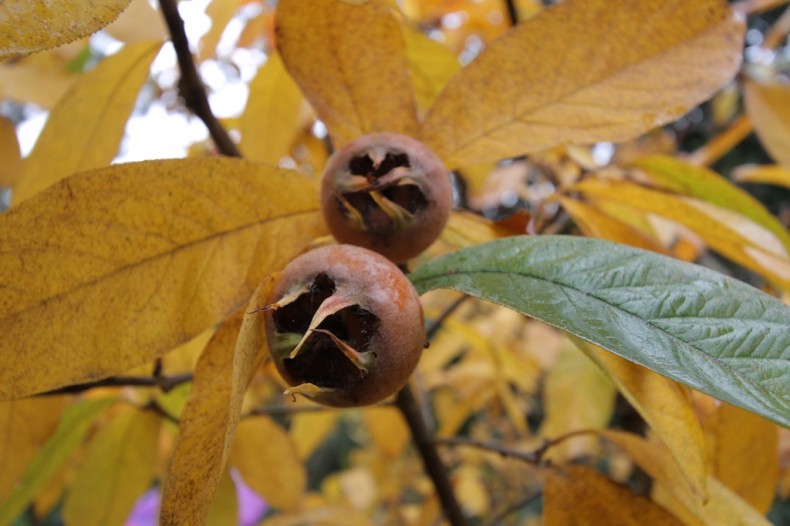
Medlars ready to pick in autumn
Medlars (Mespilus germanica) have been cultivated for centuries and are an extremely ornamental and useful hardy tree native to the south-east Europe and the eastern part of Turkey.
Single white, sometimes pink flushed unscented flowers in late spring and vibrant russet reddish-brown foliage in late autumn add to the eye appeal of the round flattened tan fruit with its indented calyx and crown of pointed sepal remnants. Fruit matures to a dark brown in late autumn to early winter. Read more
Article and photo by Gail Thomas, reproduced with permission from Good Fruit and Vegetable Magazine May 2013
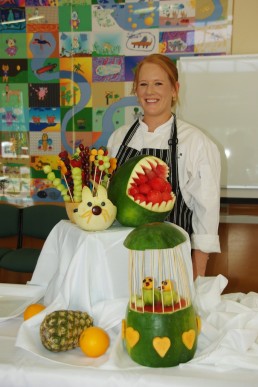
Leonie Mills with her fruit art, carved for children
Along with mentoring secondary students looking at a future in hospitality, chef and owner of Jack & Jill restaurant in Geelong Vic. Leonie Mills was eager to inspire and educate even younger palates to the delights of fresh fruit and vegetables. “I wanted something that was fun for primary groups so I’ve developed a program ‘Leonie’s Fruit Art for Kids’,” enthuses Leonie who generously gives of her time taking the program into local schools. With local fruiterer Harvey’s of Highton supplying the ingredients, Leonie’s buffet of imaginatively carved produce including watermelon sharks, fruit salad trains, rabbits, ducks and floral arrangements immediately grabs the youngsters’ attention and in no time they are excited to try the array of new taste sensations.
www.jackandjillrestaurant.com.au
By Gail Thomas
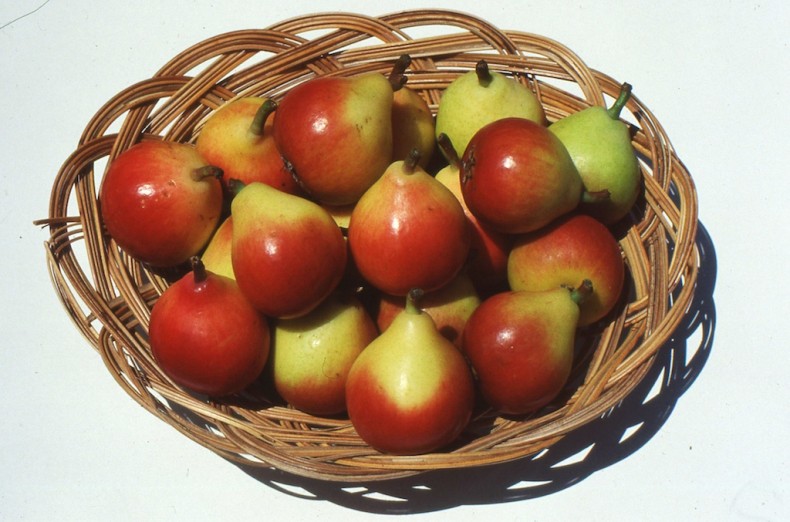
Crunchy and delicious paradise pears
There’s nothing better than a fresh juicy ripe pear, simply by itself, as a perfect match with a glass of Sauternes or in any number of sweet or savoury dishes. Kicking off the season in January and February are the delightful tiny paradise pears, also sometimes known as sugar pears, crystal pears or faccia bella, with their rosy blushed cheeks. Read more
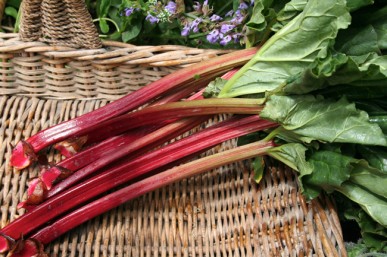
Bright red rhubarb stems
If you are an extra in a movie, providing background audience noise, you are supposed to murmur rhubarb, rhubarb, rhubarb. I don’t know where this idea originated or why rhubarb (why not cabbage, cabbage, cabbage for example!). Sometimes ‘peas and carrots’ are substituted but I do know that in Asterix the crowd always murmurs rhubarb, rhubarb, rhubarb.
Right now in gardens in Southern Australia the rhubarb clumps are thriving and many families are harvesting big bunches of stems and turning them into stewed fruit, crumbles and cakes. I have just found a new rhubarb cake recipe, it came from my sister via her friend’s grandmother and it is delicious (see the end of the article for the recipe). So, although now is not the time to plant rhubarb it is the time to harvest it and eat it. If you don’t have any, check our your neighbours’ gardens and later in the year (late winter) see if they will divide their clump and give you a piece.
Instructions for planting, growing and harvesting follow. Read more
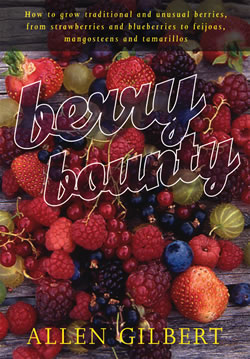 Berry Bounty, How to grow traditional and unusual berries, from strawberries and blueberries to feijoas, mangosteens and tamarillos.
Berry Bounty, How to grow traditional and unusual berries, from strawberries and blueberries to feijoas, mangosteens and tamarillos.
I’ve never quite mastered the art of growing berries but I’m hoping this book will make the difference. Allen Gilbert is a well-known and very experienced garden writer who has grown most of the berries described in the book. He is very much a hands-on gardener with books on citrus, tomatoes, nuts, apples and espalier already published. He starts this one by defining berries. Many plants that we think of as berries (strawberries and blackberries for instance) are not technically berries. While plants such as guavas, magosteens and persimmons are berries (botanically speaking). So the first part of the book covers those plants that are generally believed to be berries, namely blueberries, brambleberries, cranberries, currants, elderberries, gooseberries, jostaberries, mulberries, raspberries and strawberries. The second half looks at botanically true berries that are not included in the above list. Cape gooseberries, Chilean guava, feijoas, goji berries, guavas, jaboticabas, kiwi fruit, mangosteens, passionfruit, pawpaws, pepinos, pepperberries, persimmons, pomegranates and tamarillos. It is a great mixture of common and unusual fruits and covers everything from how to propagate, grow and harvest, to pests and diseases and how to deal with them organically, as well as some well-chosen recipes showing how to use the fruit when ripe. Read more
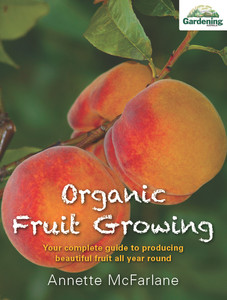 I have hundreds of gardening books in my library but only 20 or so on the ‘can’t manage without’ shelf. Organic Fruit Growing is going straight onto that shelf (Annette’s earlier book Organic Vegetable Gardening is already there). There are sections on getting started, easy fruits to start with and preparation, planting, pruning, pests, pollination and propagation. Then the A-Z with all the common fruit but also babaco, carambola, chocolate pudding fruit (tantalising?), granadilla, ice-cream bean, native limes, longan, pepino and vitamin C tree. How can you resist? Many of those I’ve just listed do best in regions with warm wet summers, but with strange things happening to our climate, who knows what we may soon be able to grow further south. I love Annette’s books because there is so much original material, written from personal experience. Whether you are a beginner or an experienced garden, this is a must have gardening book. Borrow it from your library, buy it from your local independent bookshop or go to Annette’s website to link to other Australian websites that sell the book.
I have hundreds of gardening books in my library but only 20 or so on the ‘can’t manage without’ shelf. Organic Fruit Growing is going straight onto that shelf (Annette’s earlier book Organic Vegetable Gardening is already there). There are sections on getting started, easy fruits to start with and preparation, planting, pruning, pests, pollination and propagation. Then the A-Z with all the common fruit but also babaco, carambola, chocolate pudding fruit (tantalising?), granadilla, ice-cream bean, native limes, longan, pepino and vitamin C tree. How can you resist? Many of those I’ve just listed do best in regions with warm wet summers, but with strange things happening to our climate, who knows what we may soon be able to grow further south. I love Annette’s books because there is so much original material, written from personal experience. Whether you are a beginner or an experienced garden, this is a must have gardening book. Borrow it from your library, buy it from your local independent bookshop or go to Annette’s website to link to other Australian websites that sell the book.
Organic Fruit Growing by Annette McFarlane, ABC Books, HarperCollins, Softcover, 223pages, $35
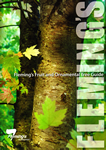 This is an updated edition of the classic Fleming’s Guide and while many of the plants listed are exclusive to Fleming’s, the cultural advice is much more widely applicable. Fleming’s Nursery is renowned in southern parts of Australia as a wholesale supplier of productive and ornamental trees. This guide details a huge range of productive trees including currants, cherries, apples, figs, pears, persimmons and more. As well as the new naturally hand pollinated F2 crosses between apricots and plums, and fruit trees grown on dwarf rootstock. Ornamental trees range from maples and hibiscus, to ginkgo and crab apples. The photos are superb. Useful for landscapers, retailers and avid gardeners the book can be purchased from Fleming’s Nursery website.
This is an updated edition of the classic Fleming’s Guide and while many of the plants listed are exclusive to Fleming’s, the cultural advice is much more widely applicable. Fleming’s Nursery is renowned in southern parts of Australia as a wholesale supplier of productive and ornamental trees. This guide details a huge range of productive trees including currants, cherries, apples, figs, pears, persimmons and more. As well as the new naturally hand pollinated F2 crosses between apricots and plums, and fruit trees grown on dwarf rootstock. Ornamental trees range from maples and hibiscus, to ginkgo and crab apples. The photos are superb. Useful for landscapers, retailers and avid gardeners the book can be purchased from Fleming’s Nursery website.
Fleming’s Fruit and Ornamental Tree Guide, Fleming’s Nursery, $29.95 (incl. postage in Australia).
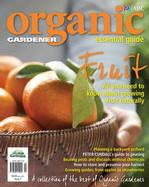 Organic Gardener Essential Guide: Fruit
Organic Gardener Essential Guide: Fruit
This mook (a cross between a magazine and a book) is the second in the series produced by Organic Gardener Magazine. It is made up of articles by well-known garden writers from across Australia. Some articles have been previously published by Organic Gardener, others are written specifically for this mook. There is everything from pruning (an article I keep going back to, to check how it should be done) by Peter Cundall to pest control by Jerry Coleby-Williams and planning the orchard by Phil Dudman. It also looks at harvesting and storing the produce. The fruits covered include apples, avocado, bananas, berries, citrus, grapes, mangoes, melons, nuts, olives, passionfruit, stone fruit and strawberries. Comprehensive and cheap at only $10.
Borrow a copy from your library, buy one from your local newsagent or go to the store on this website and buy a copy online
Last weekend saw a celebration of old cultivars and varieties of both fruit and vegetables. At Diggers Heronswood, Dromana it has been the Harvest Festival Weekend with a really beautiful array of pumpkins and squashes, garlic for sale and tomatoes to taste. Nearly all of these are heirloom or open pollinated varieties that are so important both for our gardening history and our future. Heirloom and heritage varieties are an integral part of organic gardening, many are the result of selective breeding over numerous generations so that they show special characteristics.
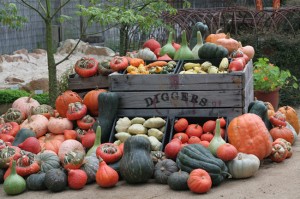
Turk's Turban, Delicata, Potimarron, Australian Butter, Buttercup and Bohemian are just a few of the heirloom varieties of pumpkins available to grow.
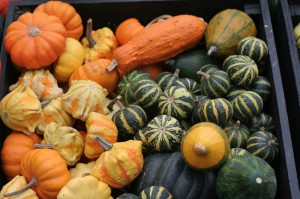
Heirloom varieties of squash, gourds and small pumpkins
Read more










